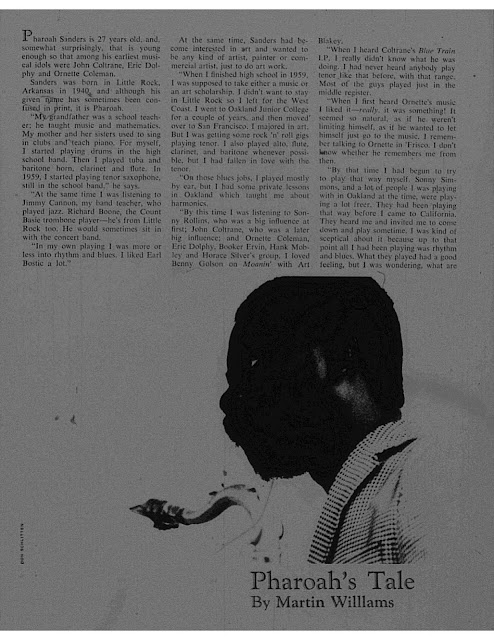This
month I've been catching up for lost time. Jason Jones' Subspace was
the winner of NZ jazz album of the year in 2000, but I'm sorry to say
that when this album was released I was completely unaware of its
existence. I've mentioned this before (and likely will again...sorry)
that around the time this album was released I wasn't very aware of
the NZ jazz scene outside my immediate vicinity. When I got to music
school you would hear some names of people from the Auckland or
Christchurch scenes (let alone anywhere else) but hearing their music
was another matter. During my time at school there was little
emphasis on NZ jazz or NZ saxophonists (but perhaps that was my
responsibility to seek it/them out). Good news is that lack of
awareness seems to have changed (although my understanding is NZ jazz
still doesn't feature much at school). My first exposure to Jones'
playing was probably 6 or 7 years after the release of Subspace via
the 1994 album Urbanism.
Aside
from Subspace and Urbanism plus his sideman work on Kim Paterson's
Impending Journey, I haven't heard his name mentioned much over the
years. Oh... and I think he's on Jazz in the Present Tense but it's
almost impossible tracking down those albums on Tap Records. A quick
search led me to the Jazzlocal32 blog
where you can watch a video of Jones playing “Everything Happens to
Me” with Dixon Nacey from a 2013 gig (keep up the good work John!).
All
seven tunes come from Jones and the stylistic/feel variety keeps
things moving - uptempo swing, laid back pieces, funk(ish), waltz,
and straight 8ths. There is some nice textural variety too –
electric and acoustic bass, the addition of flugel horn for two
tracks and percussion (with Kojo Owusu added to the ensemble) on two
others. Just a few little things that help keep the ears fresh.
Another nice touch is the solo tenor intro on “Banyan Tree” and
then changing it up to have percussion and sax take the out head. But I can't say I'm a fan of the fade-outs on three of the tracks.
Although
the he's leader, Jones leaves plenty of room for his bandmates. Piano
duties are split between Kevin Field and
Aron Ottignon. Field
sounds more confident and rhythmically more assured of the two
pianist - not all that surprising considering Ottignon must have only
been 16 or 17 when the album was recorded. These days Ottignon is
based in Europe and this recording was a nice reminder of someone I
had completely forgotten about. The piano tuning in the upper
register is a bit off and it grated on me during the initial few
listens but then subsided. However every now and then it really
sticks out (I've been listening to a bit of Monk lately and a piano
with questionable tuning in that context doesn't bother me nearly as
much as it does here).
McBride
and Gruebner are very solid throughout. “Reflections” features
the only bass solo on the album while McBride gets some solo space
with bass/piano accompaniment on “Crystal Cave” and “Subspace.”
The latter features subtle shifts and variations from McBride and
Gruebner during the horn/piano solos that keep things interesting
without overplaying. Although the solos and accompaniment on this
track largely follow the same arc with the building up and dropping
back down (not uncommon by any means) becoming a little predictable.
Kim
Paterson makes a welcome appearance on “Mandela” and the title
track. I do enjoy the sound of flugel horn (particularly in the upper
register), and there is a nice blend between the tenor and flugel
horn when they come together for the melody statements. His playing
didn't strike me at first but as the month progressed I got into it.
There's plenty of spark on “Mandela.” The hard bop(ish) intro to the title track had me thinking there was going to be more of the same, but the tunes turns into a light funk thing that isn't really my thing, even if his playing (and the others) is solid throughout. However, the tune just bring variety to the set. I have some more from Kim
Paterson lined up for this series and I'm looking forward to it.
Jones'
tone is warm throughout the range with some brightness in the upper
register and there's a pinched quality to the tone in the upper
register (more so than I remember from Urbanism). There are some
“Brecker-isms” - mostly in the upper register and a mandatory
false fingering lick. But at his core Jones seems to have melodic
concept with lyrical/melodic phrases dispersed throughout his solos.The
opening of his solo on “Dolphin Girl” keeps in the vein of the
melody without really stating or paraphrasing it. He doesn't rely
solely on strings of notes and isn't afraid of a little space to let
his lines breath. “Mandala” is a nicely paced solo and at times,
like on “Crystal Cave,” he can generate quite an up beat feeling.
A little digging around on Sounz led me to leadsheets for three tunes featured on Subspace
available for free download - “Reflections,” “Cloud Nine” and “Dolphin Girl” (I
caught myself humming the latter a number of times lately).
I was happy giving Subspace some airtime this month and as this series continues I hope to lay my ears on plenty more music that I missed along the way or is not really music I would normally reach for all that often. Up next there's a new release lined up for my December listening.










